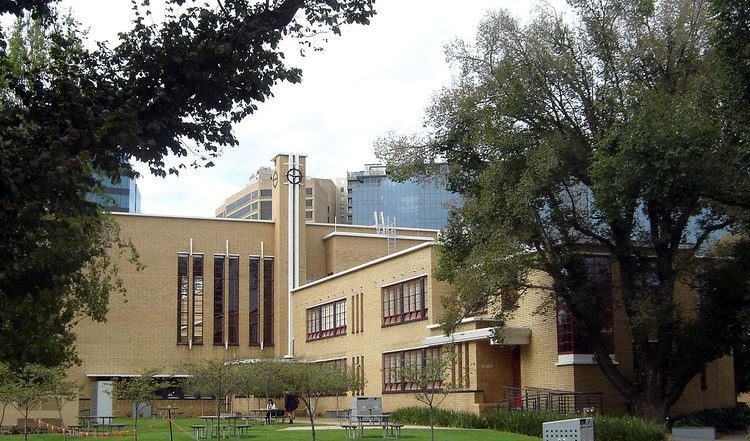 | ||
Seabrook and Fildes was a Melbourne architecture practice that played a significant role in the introduction of modernist architecture to Victoria in the 1930s. They are most well known for the Dutch modernist inspired Mac.Robertson Girls High School, designed by Norman Seabrook in 1933.
Contents
- Personal life
- MacRobertson Girls High school 1934
- Stokes and Sons 1936
- Brunswick Fire Station 1937
- Windsor Fire Station 1939
- Warracknabeal Town Hall 1940
- References
The partnership between Norman Hugh Seabrook (12 January 1906-9 September 1978) and Alan Fildes (1909–1956) was formally established in 1936, and was amongst the few in Victoria to show an influence of European modernism. By applying and adapting European modernist design principles to a broad range of civic, industrial, commercial and residential buildings, Seabrook and Fildes played a primary role in the dissemination of modernist architecture in Victoria. The practice operated as Seabrook, Fildes and Hunt from 1955 up until Fildes death in 1956, carrying on as Seabrook, Hunt and Dale until Norman Seabrook's retirement in 1976.
Personal life
Norman Hugh Seabrook was born in the Melbourne suburb of Northcote in 1906. He received his education at Brighton College, Wesley, and Hassets Commercial College Prahran, and gained his Architectural articles working for A.R. Barnes in 1924-26. He continued his studies at the University of Melbourne Architecture Atelier from 1927–31, before working for 18 months in Britain and travelling in Europe, possibly gaining first-hand experiences of the Dutch Functionalists and working on projects influenced by them in Britain. On his return to Melbourne in 1933 he won the competition to design the new Mac.Robertson Girls' High school, which he completed with the assistance of Alan Fildes, who he entered into partnership with in 1936. The partnership ended in 1956 with the death of Fildes. Seabrook taught briefly at the University of Melbourne in the 1950s, and continued practicing as Seabrook Hunt and Dale until his retirement in 1976. He died two years later in 1978.
Alan Fildes was born in the Melbourne suburb of Richmond in 1909. He studied modelling, architecture, construction and carpentry at Brighton Technical College. He received his certificate of architectural registration while working for Oakley and Parkes in 1933. By 1936 he had entered into practice with Norman Seabrook, Seabrook as the main designer, Fildes managing the projects and running the office. Alan Fildes died in 1956 at the age of 47.
Amongst the office staff of Seabrook & Fildes was Russian-born architect Anatol Kagan (1913-2009), who worked there in the late 1930s and later became a prominent practitioner in his own right.
Mac.Robertson Girls' High school, 1934
Mac.Robertson Girls' High school was constructed in 1933-34 to Norman Seabrook’s competition-winning design. It remains one of the first and best examples of Modernist architecture in Melbourne and was said by Robin Boyd to have signalled ‘the 1934 revolution’ of Victorian architecture. Influenced by Dutch Architect Willem Marinus Dudok’s Hilversum City Hall, the school was arranged in a functionalist manner, breaking the program down into series of intersecting cream-brick volumes according to De Stijl principles, interrupted by large strips of red-framed windows and blue-glazed window sills. The building was a radical departure from school buildings of the time, even including a rooftop classroom, and was the first Willem Marinus Dudok inspired building designed by Seabrook, the principles of which would be repeated and adapted through much of the practices later work.
Stokes and Sons, 1936
The factory for the silverware and medallion manufactures Stokes and Sons was constructed in Brunswick in 1936. It is a significant building for architects Seabrook and Fildes, as it saw them expand their Modernist design principles to successfully execute an industrial building type. Constructed in their signature cream-brick it broke down the traditional large factory into a series of volumes, each scaled according to its function, the largest for the manufacturing part of the complex and a lower volume for the office spaces.
Brunswick Fire Station, 1937
Brunswick Fire Station was designed for the Metropolitan Fire Brigade in 1937, and remains in operation today. It is significant for its radical shift from the Georgian revival style common to fire stations of the time, replacing historical reference with a stripped back modern functionalism. The red brick cubic composition of the Station was set apart from the domestic components, which were contained in two small blocks behind the main building, forming their own residential precinct and reflecting recent advances in European urban design.
Windsor Fire Station, 1939
Windsor fire station was a departure from the intersecting functionalist forms of the practices earlier working, reducing the massing to a simple box form with a plane offset from the side. Demolished in 1995 the building influenced Harry Winbush’s design for Kew Fire Station in 1941.
Warracknabeal Town Hall, 1940
Warracknabeal town hall (1940) was the largest civic building designed by Seabrook and Fildes, and was significant for its application of European modernist design principles to the town-hall building type, which until then had been dominated by classical reference. Situated in the rural town of Warracknabeal, the Town Hall was constructed from the practice’s signature cream-brick, and was an asymmetric composition of two large volumes with a large corner clock tower signalling the main entry. The front of the building is broken up by three vertical strips of deeply recessed windows, creating an interplay between solid and void and combined with the deep shadow over the entry suggest an adaptation of modernist design principles to an Australian climate. It also included a fully fitted out cinema, providing a social focus for the town and a means of paying for the buildings construction.
